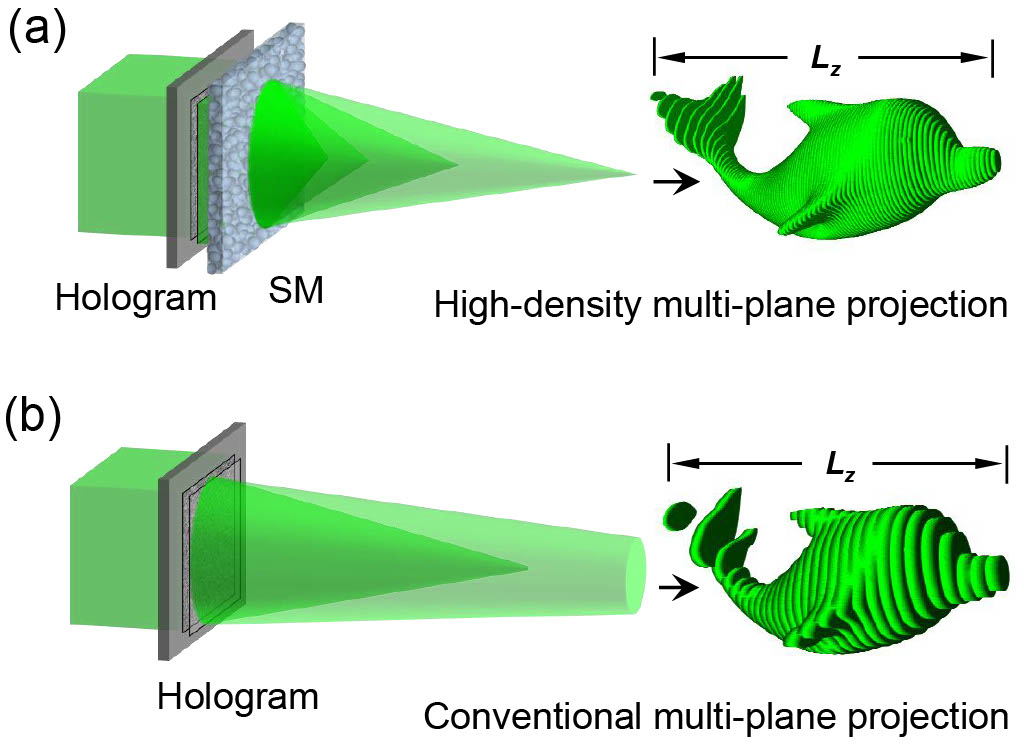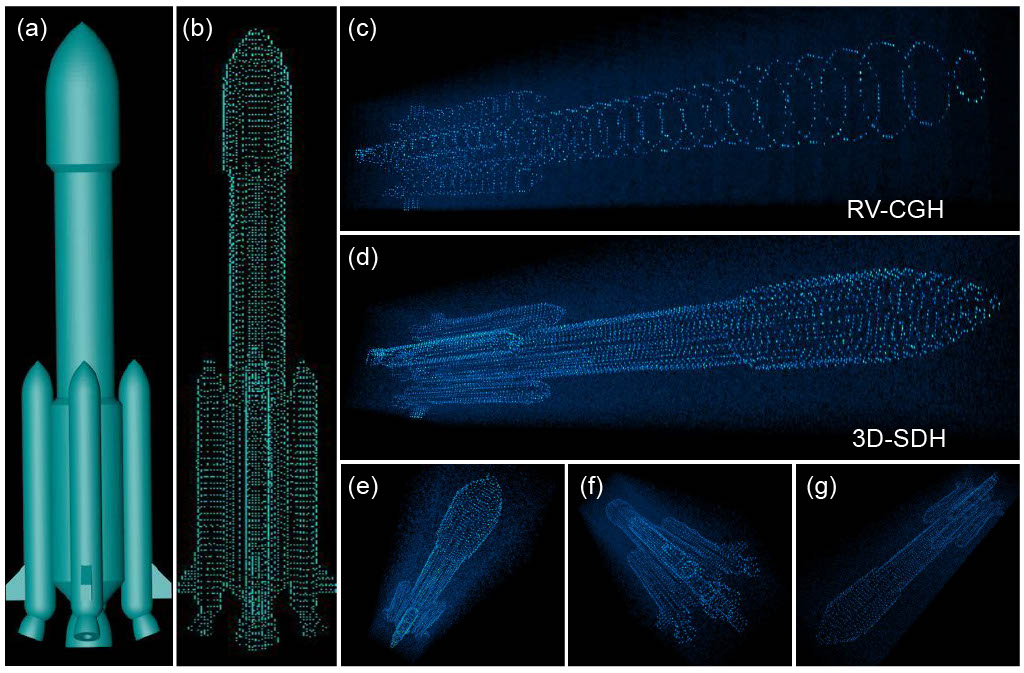About
06 April 2023
Advance in technology paves the way to realistic 3D holograms for virtual reality and more
Researchers overcome two bottlenecks in current digital holographic techniques
WASHINGTON — Researchers have developed a new way to create dynamic ultrahigh-density 3D holographic projections. By packing more details into a 3D image, this type of hologram could enable realistic representations of the world around us for use in virtual reality and other applications.
“A 3D hologram can present real 3D scenes with continuous and fine features,” said Lei Gong, who led a research team from the University of Science and Technology of China. “For virtual reality, our method could be used with headset-based holographic displays to greatly improve the viewing angles, which would enhance the 3D viewing experience. It could also provide better 3D visuals without requiring a headset.”
Producing a realistic-looking holographic display of 3D objects requires projecting images with a high pixel resolution onto a large number of successive planes, or layers, that are spaced closely together. This achieves high depth resolution, which is important for providing the depth cues that make the hologram look three dimensional.
In Optica, Optica Publishing Group’s journal for high-impact research, Gong’s team and Chengwei Qiu’s research team at the National University of Singapore describe their new approach, called three-dimensional scattering-assisted dynamic holography (3D-SDH). They show that it can achieve a depth resolution more than three orders of magnitude greater than state-of-the-art methods for multiplane holographic projection.

Caption: The new 3D scattering-assisted dynamic holography approach creates a digital hologram by projecting high-resolution images onto planes spaced closely together (a), achieving a more realistic representation than conventional holography techniques (b).
Credit: Lei Gong, University of Science and Technology of China
“Our new method overcomes two long-existing bottlenecks in current digital holographic techniques — low axial resolution and high interplane crosstalk — that prevent fine depth control of the hologram and thus limit the quality of the 3D display,” said Gong. “Our approach could also improve holography-based optical encryption by allowing more data to be encrypted in the hologram.”
Producing more detailed holograms
Creating a dynamic holographic projection typically involves using a spatial light modulator (SLM) to modulate the intensity and/or phase of a light beam. However, today’s holograms are limited in terms of quality because current SLM technology allows only a few low-resolution images to be projected onto sperate planes with low depth resolution.
To overcome this problem, the researchers combined an SLM with a diffuser that enables multiple image planes to be separated by a much smaller amount without being constrained by the properties of the SLM. By also suppressing crosstalk between the planes and exploiting scattering of light and wavefront shaping, this setup enables ultrahigh-density 3D holographic projection.
To test the new method, the researchers first used simulations to show that it could produce 3D reconstructions with a much smaller depth interval between each plane. For example, they were able to project a 3D rocket model with 125 successive image planes at a depth interval of 0.96 mm in a single 1000×1000-pixel hologram, compared to 32 image planes with a depth interval of 3.75 mm using another recently developed approach known as random vector-based computer-generated holography.

Caption: The researchers used their new method to simulate a holographic representation of a rocket [drawing shown in (a), point-cloud model in (b)]. A volume-rendered image of the 3D rocket projected by the random vector-based computer-generated holography (RV-CGH) method is shown in (c), using a single 1000×1000-pixel hologram. The 3D projection is represented by 32 images with a depth interval of 3.75 mm. Volume-rendered image of the object projected by 3D-SDH is shown in (d). 125 image planes with a uniform distance of 0.96 mm are simultaneously projected from a single 1000×1000-pixel hologram. Volume-rendered images of the simulated 3D rocket with varying perspective views are pictured in (e–g).
Credit: Lei Gong, University of Science and Technology of China
To validate the concept experimentally, they built a prototype 3D-SDH projector to create dynamic 3D projections and compared this to a conventional state-of- the-art setup for 3D Fresnel computer-generated holography. They showed that 3D-SDH achieved an improvement in axial resolution of more than three orders of magnitude over the conventional counterpart.
The 3D holograms the researchers demonstrated are all point-cloud 3D images, meaning they cannot present the solid body of a 3D object. Ultimately, the researchers would like to be able to project a collection of 3D objects with a hologram, which would require a higher pixel-count hologram and new algorithms.
Paper: P. Yu, Y. Liu, Z. Wang, J. Liang, X. S. Liu, Y. Li, C. Qiu, L. Gong, “Ultrahigh-density 3D Holographic Projection by Scattering-assisted Dynamic Holography,” 10, 4, 481-490 (2023).
DOI: : doi.org/10.1364/OPTICA.483057
About Optica Publishing Group
Optica Publishing Group is a division of the society, Optica, Advancing Optics and Photonics Worldwide. It publishes the largest collection of peer-reviewed and most-cited content in optics and photonics, including 18 prestigious journals, the society’s flagship member magazine, and papers and videos from more than 835 conferences. With over 400,000 journal articles, conference papers and videos to search, discover and access, our publications portfolio represents the full range of research in the field from around the globe.
About Optica
Optica is an open-access journal dedicated to the rapid dissemination of high-impact peer-reviewed research across the entire spectrum of optics and photonics. Published monthly by Optica Publishing Group, the Journal provides a forum for pioneering research to be swiftly accessed by the international community, whether that research is theoretical or experimental, fundamental or applied. Optica maintains a distinguished editorial board of more than 60 associate editors from around the world and is overseen by Editor-in-Chief Prem Kumar, Northwestern University, USA. For more information, visit Optica.
Media Contact
